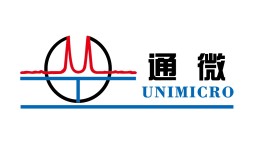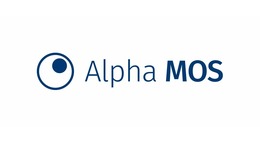方案详情文
智能文字提取功能测试中
Spectrochimica Acta Part B 118(2016)102-111Contents lists available at ScienceDirectSpectrochimica Acta Part Bjournalhomepage: www.elsevier.com/locate/sab 103Y.Lee et al. / Spectrochimica Acta Part B 118 (2016) 102-111 Multivariate classification of edible salts: Simultaneous Laser-InducedBreakdown Spectroscopy and Laser-Ablation Inductively Coupled PlasmaMass Spectrometry Analysis Yonghoon Lee a*, Sang-Ho Nam, Kyung-Sik Ham, Jhanis Gonzalez, Dayana OropezadDerrick Quarles Jr. cd Jonghyun Yoo,Richard E. Russoc,d Department of Chemistry, Mokpo National University, Jeonnam 534-729,Republic of Korea Department of Food Engineering, Mokpo National University, Jeonnam 534-729, Republic of Korea Environmental Energy Technology Division, Lawrence Berkeley National Laboratory, Berkeley, CA 94720, United States Applied Spectra, Inc., 46665 Fremont Boulevard, Fremont, CA 94538, United States ARTICLEINF O Article history: Received 17 August 2015 Revised 12 November 2015 Accepted 27 February 2016 Available online 03 March 2016 Key words:Laser-Induced Breakdown SpectroscopyLaser-Ablation Inductively Coupled PlasmaMass SpectrometryEdible saltsClassification Discrimination power 1. Introduction Salt, a natural ionic-compound mixture with a NaCl matrix, is usedubiquitously as a food additive. According to recent studies, an averageperson consumes salt ranging from a few to 10 g per day [1,2]. Salt in-take is accompanied by absorption of Na, which is known to be relatedto human diseases such as hypertension and diabetes [3-6]. Salts aregenerally produced by evaporating seawater (sea salt) on saltpans orextracted from underground areas (rock salt) where the sea had beenpreviously [7]. Some of these unrefined salts contain high-level of min-eral elements such as K,Mg, and Ca, which are dissolved in the seawater.These elements are considered as alternative nutrition sources andmitigate the high Na intake; their potential health benefits have beensuggested [8-11]. Although the main component of unrefined salts is NaCl, thechemical composition exhibits a wide variety of minor elements. Inthe case of sea salts, the chemical composition is not simply that of ( * Corresponding author. ) ( E-mail address: y hl ee @m o kpo. a c. k r (Y.Lee). ) seawater. The concentrations of the minor metallic mineral ele-ments, K, Mg, and Ca, originally dissolved in seawater, show largevariation with the density of brine water extracted from the reser-voir into the evaporation and crystallization areas of the saltpans[12,13]. Also, when the saltpan is open to the surrounding environ-ment, the dried salts tend to contain relatively high concentrationof soil particles [14,15], leading to higher concentrations of rock-formingelements (Al, Ti, Si, and Fe). For rock salts, their chemicalcomposition is originally based on that of the ancient seawater.However, inclusion of rock particles, interaction with undergroundfresh water, and chemical reactions facilitated thermally undergroundcan change the chemical composition of rock salts. The chemical com-position in unrefined salts can be utilized as reliable fingerprints forclassifying them according to their geographical origin or discriminat-ing a certain salt from others. Today, salt markets in many countries have been globalized and pre-mium unrefined salts are attracting more interests. Therefore, effectivechemical methodologies are necessary to identify the salt products cir-culated in these markets. So far, a few chemical analysis techniquesand effective indicators have been suggested for this purpose. Herradoret al. reported that K, Mg, and Sr can be used as dependable indicatorsfor edible salts marketed in Spain by using inductively coupled plasma-atomic emission spectrometry (ICP-AES)[16]. Silva et al.identi-fied ~40 volatile organic compounds in sea salts by gas chromatogra-phy-mass spectrometry and suggested that those organic compoundsserve as chemical biomarkers of sea salts thus providing informationabout the geographical origin and saltpan environment [17].Galvis-Sanchez et al. applied Fourier-transform near-infrared spectroscopyfor discriminating sea salts according to their quality and geographicalorigin [12]. Laser-Induced Breakdown Spectroscopy (LIBS) and Laser-AblationInductively Coupled Plasma Mass Spectrometry (LA-ICP-MS) are ele-mental analysis techniques based on laser ablation [18-19] and haverapidly expanded their applications in various fields [20-22]. BothLIBS and LA-ICP-MS share the strength of spatially-resolved multi-elemental analysis with little to no sample preparation; laser ablationis the underlying sampling process. However, their analytical character-istics and figures of merit are different since the nature of their signals isdifferent; the intensity and wavelength of photons versus the mass-to-charge ratio (m/z) of particles for LIBS and LA-ICP-MS, respectively. Ingeneral, LIBS utilizes simpler instrumentation and for many cases theanalysis can be performed under ambient conditions. Typical limitsof detection of metallic elements reported for LIBS are parts-per-million (ppm) to wt.% levels. On the other hand, LA-ICP-MS canreach lower concentrations on the order of sub-ppm levels [23-24].Although recently it has been found that isotopic information canbe obtained from the molecular emission from laser-inducedplasmas [25], conventional ICP-MS and LA-ICP-MS have been gener-ally used for the accurate isotopic analysis [26]. Therefore, the com-bination of LIBS and LA-ICP-MS can be used to obtain chemicalinformation over a wider concentration range. There are a few recentstudies where simultaneous LIBS and LA-ICP-MS made synergisticimprovements in quantitative and qualitative analyses [27-31]. Forexample, Dong et al. showed how this combination more accuratelypredicted the major, minor and trace elemental concentrations fromcoal samples [27]. We previously demonstrated the feasibility of rapid classificationof edible salts by using multivariate data analysis of LIBS emissionspectra [14,15,32]. The edible sea salts, recognized for rich mineralelements,typically contain K,Mg,and Ca with concentrations of sev-eral thousand ppm to a few %[15,32,33]. K, Ca, and Mg play impor-tant roles in classification of salts, but these elements are not welldetected by the ICP-MS due to overlap of abundant molecular speciesin ICP plasmas [36,37].Other elements (Li, Sr, Al, Ti, Si, and Fe) can bedetected by LIBS if their concentrations in these salts are at the ppmlevel or higher [14]. In addition, there are other trace elements in ediblesalts that could provide unique discrimination power for particularsalts, but they are not detected by LIBS due to their low concentrations[34,35]. The chemical composition and quantity of these trace elementscould reflect the effects of natural environments or contaminationaround the saltpans. The combination of LIBS and LA-ICP-MS pro-vides chemical analysis covering light metals at several hundredppm to a few %levels, non-metals, and trace heavy metals at sub-ppm levels. In this work, we demonstrated simultaneous LIBS and LA-ICP-MSanalysis for improved classification of edible salts. LIBS was optimizedfor the detection of the light elements including K, Mg, and Ca. LA-ICP-MS analysis emphasized elements with m/z ≥ 90, including non-metaland trace heavy metal elements. Our results demonstrate that LIBSand LA-ICP-MS spectra provide complementary discrimination powerfor the classification of these edible salts. Herein, the term“discrimina-tion power", means the ability of variables of LIBS or LA-ICP-MS spectrato discriminate a certain salt sample from the others [38]. The classifica-tion model based on LIBS spectra of minor metallic elements showedhigh performance, whereas the chemical information on non-metallicand trace heavy metal elements obtained from LA-ICP-MS spectraadded unique discrimination power to the classification model basedon the fused data. 2.1. Salt samples Fourteen salt samples were collected from ten countries. The geo-graphical origin and type of sample salts are listed in Table 1. The saltsfrom Mongolia, Poland, India, and Pakistan are rock salts and the othersare sea salts. Each salt sample was milled and homogenized into a finepowder using a ball mill (8000 M Mixer/Mill@, SPEX Sample Prep).Five grams of each salt was put in an agate vial with an agate ball andthen rotated at 1450 rpm for 5 min. A half gram of the milled salt pow-der was pelletized into a 13-mm diameter disk by an automated press(3630 X-PRESS, SPEX Sample Prep) under 7 ton pressure for 10 min. 2.2. LIBS and LA-ICP-MS measurements Simultaneous LIBS and LA-ICP-MS measurements were performedusing a commercial instrument (J200 Tandem LA-LIBS Instrument, Ap-plied Spectra, Inc.). A Q-switched Nd:YAG laser beam was focused onthe surface of salt samples by an objective lens (5x magnification,35 mm working distance). The wavelength, pulse duration, pulse ener-gy, repetition rate, and spot size on the sample surface were 266 nm,10 ns, 20 mJ/pulse, 10 Hz, and 150 um in diameter, respectively. Theseconditions provided good S/N for both LIBS and LA-ICP-MS measure-ments. Helium was used as the chamber gas. For each salt pellet, anarea of3 mm²(1.5mmx2mm) on the surface was sampled by a rasterscan composed of 2955 laser shots. During the analysis, the samplestage was translated at the rate of 0.1 mm/s. For the LIBS measurements,the optical emission from the laser-induced plasma was collected bytwo lenses through the top quartz window and sent to a 6-channelcharge-coupled device (CCD) spectrometer with~0.1 nm spectral reso-lution and wavelength coverage between 190 and 1040 nm. The CCDdetection gate with 1.05 ms width was delayed from the laser pulseby 1 us to minimize continuum background emission and spectral linebroadening. 123 single-shot spectra were accumulated for each spec-trum to be analyzed. A quadrupole based mass spectrometer (Plasma Quant MS Elite,Analytik Jena) was used for the ICP-MS measurements. The He carriergas flow rate was set to 0.3 L/min. The forward power for plasma gener-ation was set to 1400 W with 18.0 L/min Ar gas, auxiliary flow rateof1.8 L/min and sheath gas flow rates of 0.8 L/min. The mass spectra form/z of 6 to 239 were recorded. The m/z values (8, 12,14-26,28,30,32, 35-44,48,56,80,210-219, and 221-225) were skipped to avoidsaturated signals from the background gas (C,O, N, Ar, etc.), the majorelements of salts (Na, Cl, Mg, Ca, and K), and molecular ions. Dataacquisition for LA-ICP-MS and LIBS were synchronized. A single scanof the mass spectrum required 12.3 s. For each salt sample, 18-23pairs of accumulated LIBS and LA-ICP-MS spectra were collected. Additional LIBS experiments were performed in open air. The exper-imental conditions and parameters were the same as those used for theLIBS part of the simultaneous LIBS and LA-ICP-MS experiments above,except for the ambient gas. The LIBS spectra (in He and air) were ana-lyzed to check if non-metallic and trace heavy metal elements detectedby LA-ICP-MS are also detected in the LIBS spectra recorded in air. 3. Results and discussion 3.1. LIBS and LA-ICP-MS spectra Fig. 1 shows the averaged LIBS spectra of the salt samples fromJeung-Do, Brazil, and Poland in wavelength regions, 325-425 nm(a) and 760-830 nm (b), with assignments of the observed emissionlines based on the NIST Atomic Spectra Database [39]. Na I, Ca I and II,Mg I, Sr II, Fe I, and Al I lines are observed in the ultraviolet-visibleregion (Fig. 1a).K I, Cl I,O I, and Na I lines are observed in the near-infrared region (Fig. 1b). For the multivariate analysis, we selected Geographical origin and types of the sample salts and the elements identified in LIBS and LA-ICP-MS spectra. Na, Cl, and He, identified in all samples, were not included. Sample no. Geographical origin Type Elements identified in LIBS spectra Elements identified in LA-ICP-MS spectra 1 Laizhou, China Sea salt Si, Al, Mg, Ca, K, Sr, Li, O, H Zr,Nb, Mo,Ag, Cd, Sn, I, Cs, Ba, La, Ce, W, Pb 2 Okinawa, Japan Sea salt Mg, Ca, K, Sr, Li, S,O, H Mo, Sn, I, Cs, Ba 3 Hokkaido,Japan Sea salt Mg, Ca, K, Li, S, O, H Mo, Sn,I, Cs, Ba 4 Kochi, Japan Sea salt Mg, Ca, K, Sr, Li, S,O,H Mo, Ag, Cd, Sn, I, Cs, Ba, La, Ce, W, Pb 5 Jeung-Do, South Korea Sea salt Mg, Ca, K, Sr, Li, S, O, H Zr,Nb, Mo,Ag, Cd, Sn, I, Cs, Ba, La, Ce, Pb 6 Haenam, South Korea Sea salt Si, Al,Mg, Ca, K, Sr,Li, S, O, H Zr, Nb, Mo,Ag, Sn, I, Cs, Ba, La, Ce, W, Pb 7 Younggwang, South Korea Sea salt Si, Al, Mg, Ca, K, Sr, Li, S, O, H Zr, Nb, Mo,Ag, Sn, I, Cs, Ba, La, Ce, W, Pb 8 Guerande, France Sea salt Si, Al, Mg, Ca, K, Sr, Li, S, O, H Zr, Nb, Mo, Cd, Sn, I, Cs, Ba, La, Ce,Pb 9 Brazil Sea salt Mg, Ca, K, Sr, O, H Sn, I, Cs, Ba 10 Chile Sea salt Mg, Ca, K, Sr, O, H Sn, I, Cs, Ba 11 Mongolia Rock salt Ca, K, Li, O, H Zr, Mo, Sn I, Ba, Pb 12 Poland Rock salt Fe, Si, Al, Mg, Ti, Ca, K, Sr, Li,S, O, H Zr,Nb, Mo, Sn, I, Cs, Ba, La, Ce, Pb 13 Himalaya, India Rock salt Fe, Si, Al, Ti, Ca, K, Sr, Li, S, O,H Zr, Nb, Mo,Sn, I, Cs, Ba, La, Ce, W, Pb 14 Himalaya, Pakistan Rock salt Si, Al, Mg, Ca, K, Sr, Li, S, O, H Zr, Nb, Sn, I, Cs, Ba, La, Ce, Pb wavelength regions, 362-410 nm and 765-771 nm, instead of the fullLIBS spectra between 190 and 1040 nm. This choice is based onthe line-intensity correlation analysis for the LIBS spectra of sea salts[14] and the consideration of differences of chemical composition be-tween sea and rock salts. The partial least squares-discriminant analysis (PLS-DA) model developed using the LIBS spectra in the selected wave-length regions including Mg I, Ca I and II, Sr II, Al I, Fe I, and K Ilines shows similar classification performance to that using the fullLIBS spectral range. We compared their cross-validation correctness(Fig.6a) and confusion matrices (Fig. S1 in the Supplementary content). Wavelength (nm) This similarity indicates that these emission lines can represent most ofthe features of the full LIBS spectra that are correlated to the origin of thesample salts. This wavelength selection significantly reduced the num-ber of data points to be processed and thus led to efficient data analysis.In the following, the chemical background of this wavelength selectionis discussed. The salts from Jeung-Do and Brazil can be regarded as representa-tives for different types of sea salts. The salt from Jeung-Do is one ofthe mineral-rich sea salts with high concentrations of Mg, Ca, and Kup to a few %. Thus, in the LIBS spectrum of the Jeung-Do sample, strongMg I, Ca I and Il, and K I lines were observed. On the other hand, thereare some sea salts with very low concentrations of Mg, Ca, and K. Thesample from Brazil represents these mineral-deficient sea salts. In theLIBS spectra of the sea salt from Brazil, the Mg I, Ca I and II, and K Ilines are very weak compared to those observed from the Jeung-Dosalt sample. Thus, these samples represent the two extreme cases;mineral-rich and mineral-deficient sea salts. Previously, Mg and K con-centrations in sea salts were found to have strong positive correlationwith a coefficient of 0.917 (see Figure 6c in Ref. 14). This can be attrib-uted to the fact that both Mg and K in sea salts come from the samesource (dissolved ions, K*and Mg2+, in seawater). The strong positivecorrelation between Mg and K concentrations in sea salts makes theirdiscrimination power for sea salts not independent. Therefore, most ofthe discrimination power from the LIBS spectra could be utilized by con-sidering a few emission lines of Mg, and Ca or K, and Ca along with the Alline discriminating particular sea salts containing relatively largeamount of soil particles [14,15]. The Al concentration is correlated tothat of the other rock-forming elements, Ti, Si, and Fe [14]. The LIBS spectrum of the rock salt from Poland (Fig. 1) is used to ex-plain the difference between sea salt and rock salt samples. The varia-tion of LIBS spectral features within rock salt samples is not assignificant as that for sea salts. The LIBS spectra of the rock salt fromPoland exhibits very weak Mg I lines around 383 nm although the K Ilines at 766.5 and 769.9 nm exhibit strong intensities. Although thechemical composition of rock salts is originally based on that of ancientseawater, the Mg concentration in rock salts is frequently very low dueto the high solubility of Mg-containing ionic compound, probablyMgSO4, from the original seawater that can be easily removed by under-ground freshwater. Thus, the correlation between Mg and K can beweak in rock salts and their discrimination power would be less depen-dent on each other than that for sea salts. Another characteristic of theLIBS spectra of rock salts is the strong emission lines of the rock-forming elements (Al, Si, Ti and Fe), which might have been incorporat-ed in the rock salts during the mining process. In the LIBS spectrum ofthe rock salt from Poland, both Fe I and Al I lines show relatively strongintensities in comparison with those of the other samples. In the other wavelength regions, most of the prominent emissionlines are from Na, Cl, Mg, and Ca, with weak emission lines from Sr, Al,Li, Ti, Fe, C, and Si. The detailed assignments of the emission lines inthe full wavelength region can be found in Figures 1 and 2 of Ref. 14.The spectral intensities for the selected wavelength regions were nor-malized. The Na I line intensities at 330.2 and 819.5 nm were employedfor spectral intensity normalization as reference signals in the shorterand longer wavelength regions, respectively,since they are weak emis-sion lines of major matrix elements located closely to the analyte signals[401. Fig. 2 shows LA-ICP-MS data for the salts from Haenam, Hokkaido,Chile, Brazil, India, and Poland. The mass peaks corresponding to Zr,Mo, Nb, Sn,I, Cs, Ba, La, Ce (and other lanthanides), W,and Pb isotopeswere assigned.There are additional mass peaks at m/z= 104, 129,130, 131, 132,134, and 136. Considering the intensities, the mass peakat m/z = 104 are not assignable to any stable isotopes and tentativelyattributed to 88sr160 formed in the ICP. The other masses are assignedto the isotopes of Xe added in the Ar ICP plasma gas as impurity. TheLA-ICP-MS spectra shown in Fig. 2 indicate that the salt samples havequite different chemical compositions of heavy elements. The elements, Ba, W, Pb, I, Sn, Mo, Zr, Nb, La, Ce, etc. provide significant power fordifferentiating individual salt sample. The complementarity betweensome of these elements and those detected by LIBS is discussed inSection 3.3. For normalization of the LA-ICP-MS spectra, we could notuse the weak isotope peaks from major matrix elements Na and Cl.Therefore, the total intensity of each LA-ICP-MS spectrum (m/z=6-239) was used as a reference signal for intensity normalization. 3.2. LIBS LA-ICP-MS data fusion We performed principal component analyses (PCAs) for the LIBS,LA-ICP-MS, and their fused spectra using the Unscrambler X program(CAMO Software). The normalized spectra were mean-centered priorto the PCA. Fig. 3 shows loadings for PC1 and PC2 (a) and the corre-sponding score plot (b) obtained from PCA of the LIBS spectra. In thePC loading plots, the variables corresponding to Mg I, Ca II and I, K I,and Al I lines are indicated. From the loading plot of PC1, it was foundthat the chemical composition of our salt samples shows large varia-tions in concentrations of Mg, Ca, and K and their variations are mainlypositively correlated. Also, the loadings of PC2 indicate that the negativecorrelation between the concentrations of Mg and Ca are necessary toexplain the second most significant variation of chemical compositionfor our samples. According to the score of PC1, the sample salts can beroughly categorized into three groups (A, B and C in Fig. 3b). Althoughthis grouping is not from any statistical analysis, their separation alongthe PC1 axis is clear. The salt samples from Jeung-Do, Okinawa, andKochi consist of the sea salt group with relatively high concentrationsof Mg, Ca, and K (group A). The salts from Guerande, Younggwang,Haenam, and Hokkaido form the other sea salt group (group B). Thelower PC1 scores of the salts in group B (around0-1) than those ofgroup A (1.5-4) indicates that the concentrations of Mg, Ca, and K inthe salts in group B would be less than those in the salts in group A.All of the salts in groups A and B are sea salts. However, group Cincludesboth sea and rock salts. The PC1 and PC2 scores of the samples in groupC show clear positive correlation as indicated by the arrow in Fig. 3b.This positive correlation between PC1 and PC2 scores indicates thatthey have very small amount of Mg in common (opposite signs of thePC1 and PC2 loadings corresponding to the Mg I lines in Fig.3a). How-ever, the concentrations of Ca and K show variations to some extent,but their small PC 1 scores indicate that the concentrations are lessthan those of Ca and K in the salts in groups A and B. In group A, PC2scores of the Jeung-Do sample are separated from those of the othertwo samples from Okinawa and Kochi although these three sampleshave similar PC1 scores. This is due to the smaller intensity ratio of CaII to Mg I lines observed in the LIBS spectra of the Jeung-Do samplethan those of the others (Fig. S2 in the Supplementary content). Fig. 4 shows the loadings of PC1 and PC2 (a) and the correspondingscore plot (b) obtained from the PCA of the LA-ICP-MS spectra. The var-iables corresponding to Zr, Mo, Sn, I, Ba, W, and Pb are indicated in thePC loading plots. These elements in the salt samples were undetectableby LIBS. The PC score plot based on the LA-ICP-MS spectra (Fig. 4b)shows a significantly different clustering pattern from that based onthe LIBS spectra (Fig. 3b). These results show that the two chemical fin-gerprints recorded by LIBS and LA-ICP-MS are independent in terms ofthe main spectral variations (PC1 and PC2). The sea salts from Chileand Laizhou form two separate extreme clusters. For the salt fromChile, its high scores for PC1 and PC2 indicate that it contains relativelylarge amount of I and that the concentrations of W and Pb are very low.For the salts from Laizhou, the most negative PC1 and positive PC2scores indicate that it contains relatively high concentrations of W andPb and low concentration of I. A simple data fusion method was used to combine the independentdiscrimination powers of the LIBS and LA-ICP-MS spectra. Each LA-ICP-MS spectrum was stitched at the end of the simultaneously recordedLIBS spectrum after being multiplied by a weighting factor (WF), vary-ing the WF from 1 to 5000. Fig. 5 shows the PC score plots obtained Haenam Ba WPb Hokkaido AA Chile127I LAwA Brazil Sn IndiaZr, Mo,N1b33Cs Poland La, Ce,lanthanides m/z Fig. 2.MS spectra of the salts from Haenam,Hokkaido,Chile, Brazil, India, and Poland recorded by the LA-ICP-MS in the range of m/z=90-215(a) and the expanded LA-ICP-MS spectra inthe ranges of m/z=89.5-122(b), 138.5-160 (c), and 203-210 (d). Fig. 3. Loadings of PC1 and PC2 (a) and the corresponding score plot (b) obtained from PCA of the LIBS spectra. The arrow in the circle of group C in b indicates the positive correlationbetween the PC1 and PC2 scores of the samples in group C. Fig. 4. Loadings of PC1 and PC2 (a) and the corresponding score plot (b) obtained from the PCA of the LA-ICP-MS spectra. from the LIBS spectra (a), LA-ICP-MS spectra (h), and their fused data(b-g). The PC score plots obtained from the fused data with the differentWF values for the LA-ICP-MS spectra, 1,100,250,500,750, and 5000 are shown in Figs.5b-g, respectively. When the WFs are relatively small (1and 100), the fused-data-based PC scores show similar clustering pat-terns to that from the LIBS spectra. With relatively large WFs (750 and 0m -1 N 40- 20· -20 (a) (b) (C)0- 0-70L :s ::3LIBS W.F.=1 W.F.=100-22- -2 -2 -2 -1 0 1 2 3 -2 -1 0 2 3 -2 -1 0 2 3PC1 (84%) PC1 (84%) PC1 (80%)6(d) (e) 2- (f) 4-012一-2- 0- 一0-米 aa-2 -6-W.F.=250 W.F.=500 W.F.=7504· -8--2 -1 02 3 -3 -2 -1 0 1 2 3 -4 -2 0 2 4 6 8PC1 (62%) PC1 (37%) PC1 (39%)Jeung-Do0.010-◆JMongo(h)lia(g) PakistanGuerandeChile0.005-× %Brazil62)2o OkinawaHokkaidoPoland0 0.000 IndiaHaenamW.F.=5000 LA-ICP-MS Younggwang-60L -40 -20 20 aizh ou 40 -0.010 -0.005 0.000 0.005Kochi -2 PC1 (49%) PC1 (50%) Fig. 5. PC score plots obtained from the LIBS spectra (a), LA-ICP-MS spectra (h), and their fused data with the different WF values for the LA-ICP-MS spectra, 1 (b), 100(c),250(d),500 (e),750 (f),and 5000 (g). No. of PLS factors Fig. 6. CV correctness of the three PLS-DA models based on LIBS (a), LA-ICP-MS (b), andtheir fused data (c). In a, the CV correctness scores from the LIBS-based model using thespectra in full wavelength region to compare with those obtained using the LIBS spectrain the selected wavelength regions. 5000), the corresponding PC score plots are similar to that from the LA-ICP-MS spectra. Note that only the ranks of PC1 and PC2 were changedfor the PC score plot in Fig. 5f (WF=750) and the clustering pattern issimilar to that in Fig.5g. Therefore, effective data fusion would be ob-tained with the intermediate WFs = 250 and 500. The WF = 250shows the best separation among the individual clusters; the ninesalts of the fourteen total samples form their own clusters well separat-ed from the others. Herein, we investigated how LIBS, LA-ICP-MS, and their fused datadistinguish the sample salts in terms of main spectral variations, PC1and PC2. According to the later PCs such as PC3 and PC4 extractedfrom the LIBS, LA-ICP-MS and their fused data, the relevant PC scoresform clusters. The loadings of PC3 and PC4 along with those of PC1and PC2 and the PC1-PC3 and PC1-PC4 score plots can be found inthe Supplementary content (Figs. S3-S5). 3.3. Classification models We tested three PLS-DA classification models based on the LIBS,LA-ICP-MS, and their fused data with WF = 250 for the 14 salt sam-ples listed in Table 1. A LIBS Graphical Development Tool (LIBS GDT,New Folder Consulting) was used for the PLS-DA analysis. The modelperformances were validated by using a cross-validation (CV) meth-od with a leave-one-out (LOO) algorithm [41]. In the validation pro-cess, we made as many sub-models as there are spectra, each timeleaving out just one of the objects and only using this for testing(classifying the sample identity of the spectrum kept from the dataset for modeling). The correctness scores for testing were obtainedfor the models with different numbers of PLS factors from 1 to 20.In Fig.6, the CV correctness scores are plotted with respect to thenumbers of PLS factors included in the models based on the LIBS,LA-ICP-MS and their fused data. In Fig. 6a, the CV correctness scores Response (b) LA-ICP-MS model Brazil 9 0 0 0 0 0 0 0 91 0 0 Chile 0 l100 0 0 0 0 0 0 0 Guerande 01 0 22 0 0 0 0 0 0 67 0 11 0 Haenam 0 0 71 01 0 0 0 0 29 Holdcaido 51 0 731 0 0 0 5 18 0 0 0 iindla 0 0 0 0 100 0 0 0 0 0 0 Jeung-Do 0 0 0 5 0 0 0: 95 0 0 Kochi 01 0 0 0 0 100 01 0 0 0 Laizhou 0 0 01 0 0 100 0 0 0 Mongolia 0 0 0 0 0 95 0 0 Qhinaww 0 0 0 0 100 0 0 Pakistan 0 0 0 0 0 0 0 0 0 82 18 0 Poland o 0 5 0 9 0 38 50 0 Yoursewang 0 52 0 0 0 0 0. 0 0 0 48 一工 口口琴 Response (c) Fused data model Brazil 100 0 0 0 0 0 0 0 0 0 0 Chitle 0 100 0 0 0 0 0 0 0 Guerande 0 100 0 0 0 0 0 0 01 0 Haenam 0 0 67 0 0 0 0 0 0 0 33 Hokkaido 0 0 0 100 0 0 0 0 0 0 0 0 india 0 0 0 0 0 l100 0 0 0 0 0 0 0 0 Jeung·Do 0 0 0 211001 0 0 0 0 0 01 Kochi 0 0 0 0 9 100 0 0 0 0 Laizhou 0 0 0 01 0 100 0 0 0 0 Mongolia 0 0 0 0 0 0 0 100 0 D 0 O省inaw 0 0 0 0 1 0 0 0 Pakistan 0 0 0 0 0 0 0 0 01 100 0 Poland 0 0 0 0 0 0 0 95 0 0 0 0 0 0 0 0 0 0 100 (a)o8 (b) Brazil 0.3 Brazil 0.6 0.2 0.4· 0.2- 0.1 0.0· 0.0 0.8·c Chile 0.3 Chile 0.6- 0.4- 0.2 0.2- 0.1 0.0 Wavelength (nm) Wavelength (nm) (c) Fig. 9. Two-dimensional loading plot that shows the relationship between PC1 and PC2extracted from the LA-ICP-MS spectra and also the relationship between the mass signalintensity at each m/z and the latent variables. The variables (data points in the LA-ICP-MS spectra) corresponding to I, W, and Ba isotopes are indicated. Also, the inset showsthe expanded plot around the area of 127I isotope mass signal with the correspondingm/z values. wavelength region shows a similar confusion matrix to that based onthe LIBS spectra in the selected wavelength (Fig. S1 in the Supple-mentary content); that the selected regions in LIBS spectra providedmost of the discriminating power that can be extracted from the fullspectra. For all three models based on the different data sets (LIBS, LA-ICP-MS, and their fused data), inclusion of more PLS factors leads to higherCV correctness scores. However, the CV correctness tends to saturatesince PLS factors later than around PC10 are not effective at discrimina-tion compared to the major factors. For most cases with different num-bers of PLS factors, the LIBS model shows the higher CV correctnessscores than those of the LA-ICP-MS model. The maximum (or saturated)CV correctness score of the LIBS model is higher than that of the LA-ICP-MS model by ~20%. From these results, the LIBS spectra are found to bemore effective in classifying the sample salts than the LA-ICP-MS spec-tra. However, the model based on the LIBS LA-ICP-MS fused datashows the highest CV correctness score and has more effective factorsbefore the CV correctness score saturates. This result shows that theLA-ICP-MS spectra do provide discrimination power complementaryto that of the LIBS spectra although the LA-ICP-MS model was not aseffective as the LIBS model. The larger number of effective PLS factorsin the model based on the fused data compared to those of the LIBSand LA-ICP-MS spectra is consistent with this result. Fig. 7 shows the confusion matrices generated from the CV usingLOO algorithm for the PLS-DA models using the LIBS (a), LA-ICP-MS (b), and fused data (c). To avoid over-fitting the models, we chose thenumber of factors corresponding to a break from monotonically increas-ing the correctness scores for each model (9, 10, and 12 PLS factors forthe LIBS, LA-ICP-MS, and fused data models, respectively). All correct-ness values in the confusion matrices are in . The overall LLO CV cor-rectness scores of the model based on the fused data is 97.4% andthose of LIBS and LA-ICP-MS models are 87.2 and 68.8%, respectively.From the confusion matrix in Fig. 7a, the main cause deteriorating theperformance of LIBS model is identified as the poor discriminationcapability of the salt sample from Brazil, even with 9 PLS factors. Thissample is misidentified as the salt from Chile with 100% probability inthe LOO CV. In the LA-ICP-MS model with 10 PLS factors, the salt samplefrom Brazil is also mostly misidentified as the Mongolian rock saltsample with only 9% correctness score. However, the model based onthe fused data shows 100% correctness score for identification of thesalt sample from Brazil. This result clearly demonstrates that the combi-nation of chemical information from LIBS and LA-ICP-MS improves theclassification performance of these edible salts. Fig.8 shows the LIBS(a and b) and LA-ICP-MS (c) spectra of the salt samples from Brazil,Chile, and Mongolia. In the LIBS spectra, the emission lines from Caand K are stronger for the Mongolian rock salt sample than the saltsamples from Brazil and Chile. On the other hand, the emission linesfrom Mg are stronger for the Brazilian and Chilean salts than theMongolian salt (Fig. 8a andb). This feature distinguishes the Braziliansalt well from the Mongolian salts. However, similar features of LIBSspectra between the salt samples from Brazil and Chile make it difficultto distinguish the Brazilian salt from the Chilean salt. In the PC score plotbased on the LA-ICP-MS data (Fig. 4b), the Brazil salt cluster was wellseparated from that of the Chile salt cluster along the axis betweenPC1 and PC2. The LA-ICP-MS spectrum of the Brazilian salt is significant-ly different from that of the Chilean salt, but not much different fromthat of the Mongolian rock salt (Fig. 8c). The two-dimensional loadingplot in Fig.9 shows the relationship between PC1 and PC2 extractedfrom the LA-ICP-MS spectra and also their relationship with the mea-sured mass signal intensity at each m/z value. Thus, we can find the con-tribution of each data point in the LA-ICP-MS spectra to PC1 and PC2 inthis plot. The data points corresponding to 127I have positions in thisplot that correspond to the direction indicated by the arrow in Fig. 4b.The inset shows the expanded plot around the position where thedata points corresponding to 12I are located with the numbers indicat-ing the m/z values. This means that the salt sample from Chile shows astrong I isotope mass signal (high concentration of I), and this distin-guishes the Chilean salt from the others. The 1271 signal intensity is ~6times stronger in the LA-ICP-MS spectrum of the Chile salt than that ofthe Brazil salt (see Fig.2a). About half of the LIBS spectra of the sea salt from Haenam resultedin misidentification as the sea salts from Hokkaido and Younggwang(Fig. 7a). With the aid of LA-ICP-MS spectra, the misidentification tothe sea salt from Hokkaido could be corrected; the corresponding mis-identification probability was decreased from 19% to 0% by data fusion(Fig.7c). This can be attributed to the higher concentrations of Ba, W,and Pb in the salt from Haenam than those in the salt from Hokkaido(compare the Ba, W, and Pb mass peak intensities of the two saltsshown in Fig.2). However, the LOO CV performance of the fused datamodel is still deteriorated mainly by the misidentification of the saltfrom Haenam as the salt from Younggwang (Fig.7c). This is easily un-derstood by the fact that both LIBS and LA-ICP-MS models show signif-icant misidentifications for the two salt samples. In fact, the saltpans,where the two sea salts were produced, are very closely located in thesouthwest coast of South Korea. Our simultaneous LIBS and LA-ICP-MS experiments were performedin He gas for optimum performance of LA-ICP-MS analysis. Since theemission lines from laser-induced plasmas are generally stronger inair than in He, we checked the detectability of LIBS in air for the ele-ments such as I, Ba, W,and Pb observed by LA-ICP-MS in He. As a result,only a very weak Ba line could be measured by LIBS in air. Details for the 4. Conclusion Simultaneous LIBS and LA-ICP-MS analysis was demonstrated forthe classification of edible salt samples. LIBS and LA-ICP-MS werefound to classify the sample salts in different ways. The two differentdata sets were fused to have similar contribution to the main features(not to be dominated by one part) with an appropriately selectedweighting factor. The LIBS spectra provided a model with significantlyhigher LOO CV performance than that based on the LA-ICP-MS spectraof heavier elements (m/z ≥ 90). The fusion of LIBS and LA-ICP-MS dataprovided the best performance than those of both LIBS and LA-ICP-MSmodels alone; the two elemental analyses data sets provide comple-mentary information for salt classification. The fused data model gainsmost discrimination power from the LIBS spectra. Additionally, thechemical information about non-metals and trace heavy metals (I, Ba,W, and Pb) from the LA-ICP-MS spectra is effective in classifying someparticular salt samples. The LIBS and LA-ICP-MS have strengths in anal-vsis of different kinds of elements at different concentration levels. Thisenables the combination of LIBS and LA-ICP-MS to simultaneously pro-vide more accurate chemical fingerprints for the classification of ediblesalts. Acknowledgment This paper was supported by Research Funds of Mokpo National Uni-versity in 2015, and a Grant 20130290 to the Solar Salt Research Center,Mokpo National University (MNU), from Ministry of Oceans and Fisher-ies of Korea. The research at the Lawrence Berkeley National Laboratorywas supported by the Office of Basic Energy Sciences, Chemical ScienceDivision of the U.S. Department of Energy under contract number DE-AC02-05CH11231. Appendix A. Supplementary data Supplementary data to this article can be found online at http://dx.doi.org/10.1016/j.sab.2016.02.019. ( References ) [1] M. O'Donnell, M.J. McQueen, H. Yan, A. Rosengren, A. Averzum, R. Iqbal,S. Gulec, R.Yusuf, G. Dagenais, S. Yusuf, Urinary sodium and potassium excretion, mortality, andcardiovascular events,N. Engl.J. Med. 371 (2014) 612-623. [2]1M.J. Morris, E.S. Na, A.K. Johnson, Salt craving: the physiology of pathogenic sodiumintake, Physiol. Behav. 94 (2008) 709-721. [3]M.H. Alderman, Salt, blood pressure and health: a cautionary tale, Int. J. Epidemiol.31(2002)311-316. [4] F.J. He, G.A. MacGregor, Reducing population salt intake worldwide: from evidenceto implementation, Prog. Cardiovasc. Dis. 52 (2010) 363-382. [5]C.M. Champagne, K.C. Lastor, Sodium intake: challenges for researchers attemptingto assess consumption relative to health risks, J. Food Compos. Anal. 22S (2009)S19-S22. [6]1E.I. Ekinci, K. Cheong, S. Clarke,R.J. MacIsaac, M.C. Thomas, G. Jerums,J.L.Moran,Di-etary salt intake and mortality in patients with type 2 diabetes, Diabetes Care 34(2011) 703-709. [7S]alt production method,http://www.saltinstitute.org/salt-101/production-indus-try/. [8]T.-C. Gao, J.-Y. Cho, L.-Y. Feng, S. Chanmuang, S.-Y. Park, C.-K. Auh, T.-K. Pai, K.-S.Ham, Mineral-rich solar sea salt generates less oxidative stress in rats thanmineral-deficient salt, Food Sci. Biotechnol. 23 (2014)951-956. ( [9] T. Kaw a s a k i , K. Ito h , M . K a wasaki, R ed uc ti o n i n b loo d p r essu re w i t h a s od iu m - r edu c e d ,po tass i um - a n d ma g n es i um - enr i c h ed min er al s a l t i n s u bjects w ith m ild e ssential h ypertension, H ypertens . Res . 2 1 ( 19 9 8 ) 235- 2 43. ) ( [10] E .S. S a r k k i n e n, M. J . K a s ta ri nen , T .H . N i s ka n e n, P.H. Kar j a lainen, T .M . V en a la ine n, J. K. U dani , L . K . N i sk a ne n , F e a si bi l it y and an ti h yp er t en siv e e ff ect o f r ep l a c ing r e g u l a r salt w ith m i ner a l s a l t - r ich in m a g ne sium an d p o ta ss ium - i n su bje c ts w i th m i l dl y e l e v a t e d b lood p r ess u r e, N ur . J . 10 ( 2 0 1 1 ) 8 8 . ) ( [ 11 ] lP . E . R ay , S.I. Suga, X.H. Li u , R . J o hn s on, Ch r on ic pot ass i u m d eplet i o n i nd u ces r en al i njur y, salt se ns itivit y , a n d hyper t ensi o n i n y ou ng r a ts , K i dne y In t . 5 9 ( 2 0 0 1 ) 1 850-1 8 5 8 . ) [12] A.C. Galvis-Sanchez, J.A. Lopes, I.Delgadillo, A.O.S.S. Rangel, Fourier transform near-infrared spectroscopy application for sea salt quality evaluation,J. Agric. Food Chem.59(2011)11109-11116. [13] A. Giinter, D. Knake, J. Schneider, H. Peters, Geochemistry of modern seawater andbrines from salt pans: main components and bromine distribution,Contrib. Mineral.Petrol. 40(1973)1-24. [14] Y. Lee, K.-S. Ham,S.-H. Han, J. Yoo, S. Jeong, Revealing discriminating power of theelements in edible sea salts: line-intensity correlation analysis from laser-inducedplasma emission spectra, Spectrochim. Acta Part B 101 (2014) 57-67. [15]M.M. Tan, S. Cui, J. Yoo, S.-H. Han, K.-S. Ham, S.-H. Nam, Y. Lee,Feasibility of laser-induced breakdown spectroscopy (LIBS) for classification of sea salts, Appl.Spectrosc.66 (2012) 262-271. [16] M.A. Herrador,A.G. Gonzalez, A.G. Asuero, Inorganic indicators of the origin of ediblesalts marketed in Spain from a chemometric approach,J. Food Prot. 61 (1998)891-895. [17] I. Silva, S.M. Rocha, M.A. Coimbra, Headspace solid phase microextraction and gaschromatography-quadrupole mass spectrometry methodology for analysis of vola-tile compounds of marine salt as potential origin biomarkers, Anal. Chim. Acta 635(2009) 167-174. [18]D.W. Hahn,N.Omenetto, Laser-induced breakdown spectroscopy (LIBS), part Il: re-view of instrumental and methodological approaches to material analysis and appli-cations to different fields, Appl. Spectrosc.66 (2012) 347-419. [19] N.S. Mokgalaka,J.L. Gardea-Torresdey, Laser Ablation Inductively Coupled PlasmaMass Spectrometry: principles and applications, Appl. Spectrosc. Rev. 41 (2006)131-150. [20]R.E.Russo,X. Mao,JJ. Gonzalez, V.Zorba, J.Yoo, Laser ablation in analytical chemis-try, Anal. Chem. 85 (2013) 6162-6177. [21] F.J. Fortes,J. Moros, P. Lucena, L.M. Cabalin, J.J. Laserna, Laser-induced breakdownspectroscopy, Anal. Chem. 85 (2013)640-669. [22]E.H. Evans, J. Pisonero, C.M.M. Smith, R.N. Taylor, Atomic spectrometry update: re-view of advances in atomic spectrometry and related techniques, J. Anal. At.Spectrom. 30 (2015) 1017-1037. [23] J.S. Becker, State-of-the-art and progress in precise and accurate isotope ratio mea-surements by ICP-MS and LA-ICP-MS, J. Anal. At. Spectrom. 17 (2002) 1172-1185. [24] F.Vanhaecke, M. Resano, J. Koch, K. McIntosh, D. Gunther, Femtosecond laserablation-ICP-mass spectrometry analysis of a heavy metallic matrix: determinationof platinum group metals and gold in lead fire-assay buttons as a case study,J. Anal.At. Spectrom. 25 (2010) 1259-1267. [25] X. Mao, A.A. Bol’shakov, I. Choi, C.P. McKay, D.L. Perry,O. Sorkhabi, R.E. Russo, LaserAblation Molecular Isotopic Spectrometry: strontium and its isotopes, Spectrochim.tB 66(2011)767-775Acta Part B 66(2011)767-775. [26] T. Trejos, A. Flores, J.R. Almirall,Micro-spectrochemical analysis of document paperand gel inks by laser ablation inductively coupled plasma mass spectrometry and laser induced breakdown spectroscopy, Spectrochim. Acta Part B 65 (2010)884-895. [27] M.Dong, D. Oropeza,J. Chirinos, JJ. Gonzalez, J. Lu, X. Mao, R.E. Russo, Elementalanalysis of coal by tandem laser induced breakdown spectroscopy and laser ablationinductively coupled plasma time of flight mass spectrometry, Spectrochim. ActaPart B 109 (2015) 44-50. [28]| JJ.R. Chirinos, D.D. Oropeza, JJ.Gonzalez, H. Hou, M. Morey,V. Zorba, R.E. Russo, Si-multaneous 3-dimensional elemental imaging with LIBS and LA-ICP-MS, J. Anal.At. Spectrom. 29 (2014) 1292-1298. ( [29] K . S ub ed i,T. Tr e j os, J . Alm iral l , F o ren s i c an alysis of pr in t i ng in k s u si ng tan d em L as er In duced B r e ak d o w n S pe c t r o s c o py a n d Las e r A b l at io n I n d uc t i vel y Cou p le d P l asma M a s s Spect r om e try, S pec t rochim . A cta P art B 103-104 ( 2 015) 7 6 -83. ) [30]|( C. Latkoczy,T. Ghislain, Simultaneous LIBS and LA-ICP-MS analysis of industrial sam-ples, J. Anal. At. Spectrom. 29 (2014) 1292-1298. [31]M. Bonta,J.J.Gonzalez, C.D. Quarles Jr., R.E. Russo,B. Hegedus, A. Limbeck,Elementalmapping of biological samples by the combined use of LIBS and LA-ICP-MS, J. Anal.At. Spectrom. 31 (2016) 252-258. [32]G. Park, H. Yoo, Y. Gong, S. Cui, S.-H. Nam, K.-S. Ham,J. Yoo, S.-H. Han, Y. Lee, Feasi-bility of rapid classification of edible salts by a compact low-cost laser-inducedbreakdown spectroscopy device, Bull. Kor. Chem. Soc. 36 (2015) 189-197. [33] S.L. Drake, M.A. Drake, Comparison of salty taste and time intensity of sea and landsalts from around the world, J. Sens. Stud. 26 (2011)25-34. [34] M. Soylak, D.S.K. Peker, O. Turkoglu, Heavy metal contents of refined and unrefinedtable salts from Turkey, Egypt and Greece, Environ. Monit. Assess. 143 (2008)267-272. [35]H. Pourgheysari, M.Moazeni, A. Ebrahimi, Heavy metal content in edible salts inIsfahan and estimation of their daily intake via salt consumption, Int. J. Environ.Health Eng. 1 (2012) 41-45. [36]S.H. Tan, G. Horlick, Background spectral features in inductively coupled plasma/mass spectrometry, Appl. Spectrosc. 40 (1986)445-460. [37] N.M. Reed, R.O. Cairns, R.C. Hutton, Characterization of polyatomic ion interferencesin inductively coupled plasma mass spectrometry using a high resolution massspectrometer,J. Anal. At. Spectrom. 9 (1994)881-896. [38]K.H.Esbensen,Multivariate Data Analysis-In Practice,5th ed. CAMO Inc., 2004 349. ( [39] NI 1 ST Atomic Spectra Database, h t tp: / /www.n i s t .go v /p m l/ d ata/asd.cfm. ) [40]N.B. Zorov,A.A. Gorbatenko, T.A. Labutin, A.M. Popov, A review of normalizationtechniques in analytical atomic spectrometry with laser sampling: from sample tomultivariate correction, Spectrochim. Acta Part B 65 (2010)642-657. [41] K.H. Esbensen, Multivariate Data Analysis-In Practice, 5th ed. CAMO Inc., 2004163-164. 在此项研究中,我们同时进行了LIBS和LA-ICP-MS分析,以改进食用盐的分类。LIBS对K、Mg、Ca等轻元素的检测进行了优化,LA-ICP-MS着重分析m/z ≥90的元素,包括非金属元素、痕量重金属元素。结果证明,LIBS和LA-ICP-MS光谱为这些食用盐的分类提供了互补的辨别能力。在这里,“辨别能力”一词,是指LIBS或LA-ICP-MS光谱的变量从其他盐样中分辨出某一盐样品的能力[38]。基于少量金属元素LIBS光谱的分类模型表现出较高的性能,而基于融合数据的LA-ICP-MS光谱对非金属和痕量重金属元素的化学信息为分类模型增加了独特的识别能力
关闭-
1/10

-
2/10
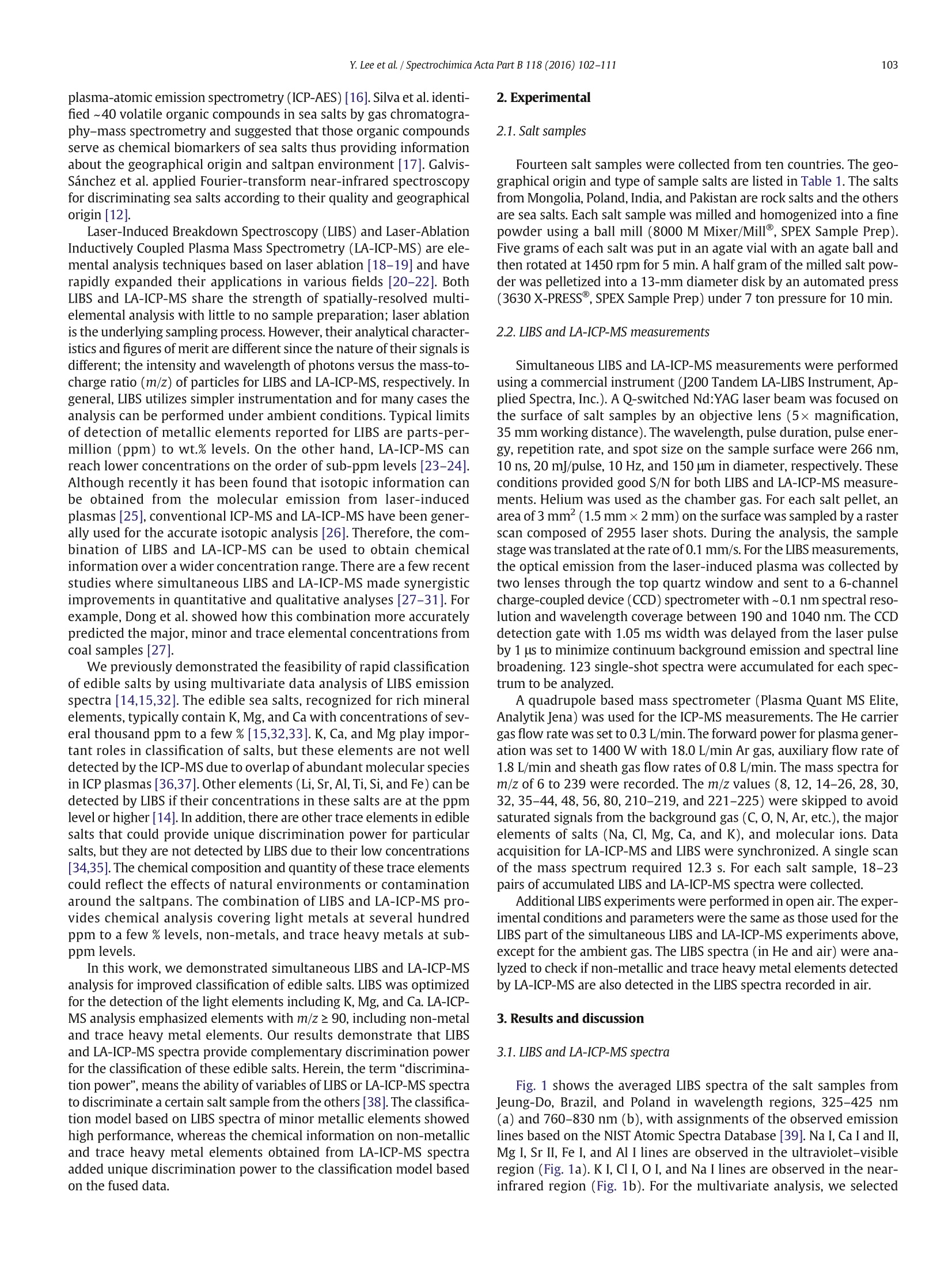
还剩8页未读,是否继续阅读?
继续免费阅读全文产品配置单
北京富尔邦科技发展有限责任公司为您提供《食盐中多元分类检测方案(激光诱导击穿)》,该方案主要用于固态复合调味料中理化分析检测,参考标准《暂无》,《食盐中多元分类检测方案(激光诱导击穿)》用到的仪器有美国ASI 激光剥蚀—激光诱导击穿光谱复合系统。
我要纠错
推荐专场
相关方案


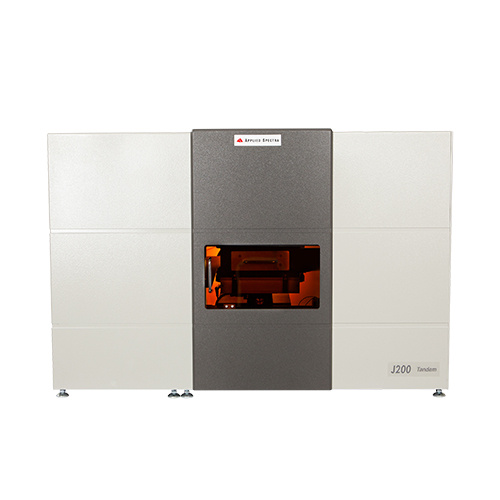
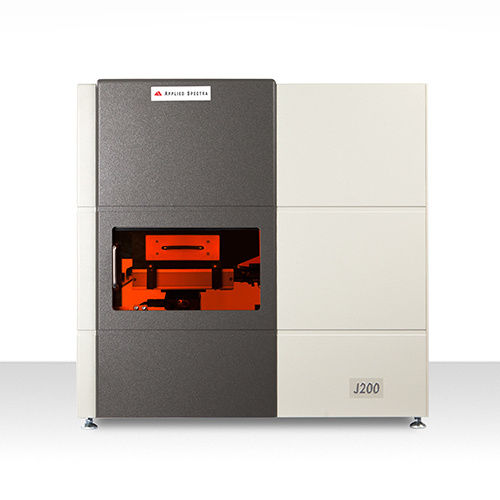
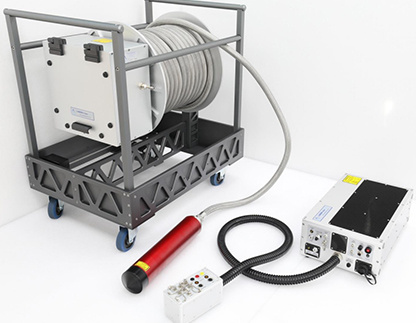
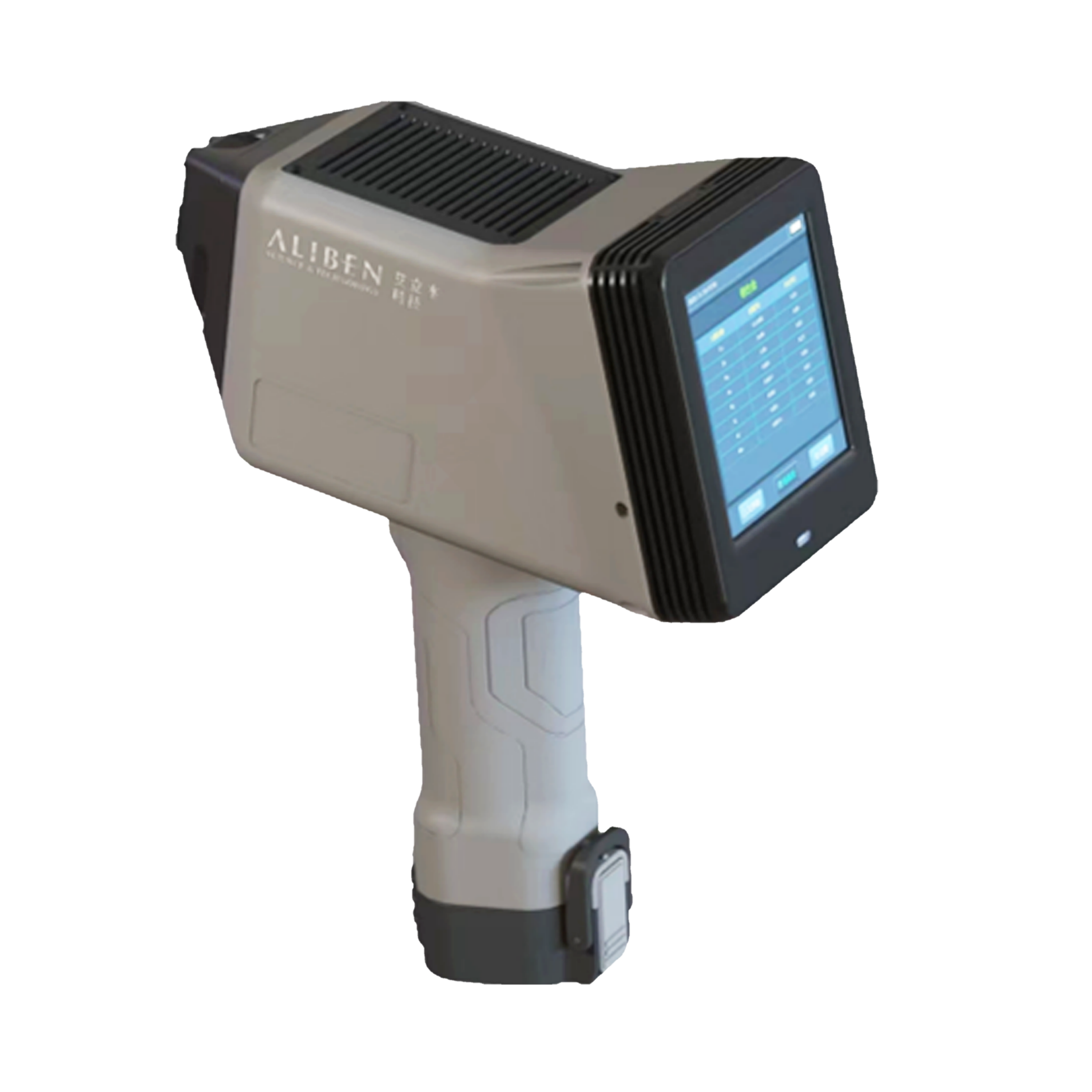
 咨询
咨询


